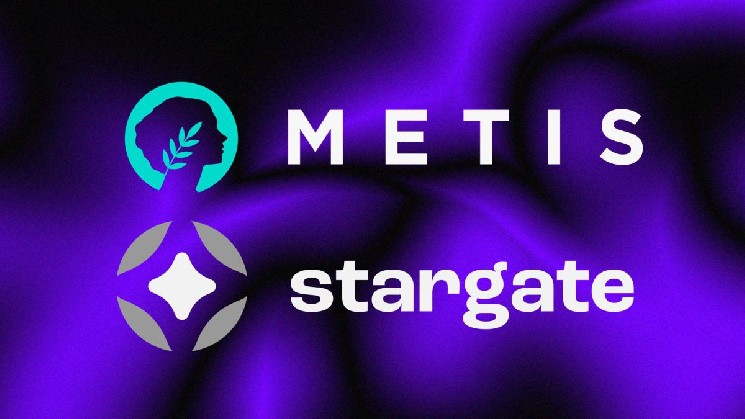Stargate integrates with Metis in first blockchain expansion since launch

Cross-chain bridge protocol Stargate has integrated with the Layer 2 Ethereum scaling solution Metis in its first blockchain expansion since it was launched by LayerZero Labs in March last year.
Stargate’s integration with Metis aims to provide more flexibility for projects managing their funds, treasury, and yield strategies, according to an announcement.
“Web3 represents community and decentralization, both of which must begin at the infrastructural level. We firmly believe that, alongside the Stargate team, our partnership is a major step toward eliminating the barriers between blockchains and opening the doors to a more decentralized, multi-chain economy,” said Metis CEO and co-founder Elena Sinelnikova.
Multi-chain liquidity
Stargate went live in March 2022 on Ethereum, Avalanche, Polygon, BNB Chain, Fantom, Arbitrum and Optimism, shortly after raising $25 million in a public sale of its native stargate tokens (STG). The multi-chain bridge gained $4 billion of liquidity within two weeks of the launch, attracted by 20-25% yields, but that has since fallen to around $350 million alongside the general crypto market decline.
Metis’s $95 million of assets held make it the fourth largest Layer 2 network, behind Arbitrum, Optimism and Loopring, dropping from a high of $743 million.
The new partnership aims to bring Metis users greater cross-chain efficiency, with the ability to leverage the benefits of DeFi across multiple chains supported by LayerZero.
“The integration of Metis is another big step in LayerZero’s expansion into the Layer 2 ecosystem of Ethereum, allowing for a unified flow of messaging across the entire Ethereum ecosystem,” added LayerZero Labs co-founder and CTO Ryan Zarick.
Metis and Stargate intend to continue their collaboration on an ongoing basis. Initially, Stargate will enable USDT for Metis across Ethereum, Avalanche, and BNB Chain, with plans to expand interoperability further.
How Stargate works
The ability to transfer liquidity across blockchain networks is a key part of web3 interoperability. Yet, most existing cross-chain bridges are unable to send native assets between chains without relying on wrapped tokens for the bridging process.
Bridging with wrapped tokens relies on multi-step locked liquidity models — locking up a crypto asset on one chain with a corresponding wrapped token minted on another. Regardless of whether those locked funds are stored in a multi-sig, smart contract or with a third-party custodian, they can become a target, with over $2.5 billion stolen from such cross-chain bridges in the past two years. In fact, a recent study showed around 50% of all DeFi exploits occurred on cross-chain bridges.
Built on the interoperability protocol LayerZero, Stargate is designed to avoid the need for wrapped tokens, improving security, its team claims.
Stargate’s fully composable native asset bridge enables the transfer of native tokens between different blockchains in a single transaction. It does this by building unified liquidity pools that are shared between chains with instant transaction finality.






 Bitcoin
Bitcoin  Ethereum
Ethereum  Tether
Tether  USDC
USDC  Dogecoin
Dogecoin  TRON
TRON  Cardano
Cardano  Stellar
Stellar  Chainlink
Chainlink  Hedera
Hedera  Bitcoin Cash
Bitcoin Cash  Litecoin
Litecoin  LEO Token
LEO Token  Monero
Monero  Cronos
Cronos  Dai
Dai  Ethereum Classic
Ethereum Classic  OKB
OKB  Algorand
Algorand  VeChain
VeChain  Cosmos Hub
Cosmos Hub  Gate
Gate  KuCoin
KuCoin  Stacks
Stacks  Tezos
Tezos  Theta Network
Theta Network  IOTA
IOTA  Tether Gold
Tether Gold  Zcash
Zcash  TrueUSD
TrueUSD  NEO
NEO  Polygon
Polygon  Decred
Decred  Dash
Dash  Ravencoin
Ravencoin  Qtum
Qtum  Basic Attention
Basic Attention  Zilliqa
Zilliqa  0x Protocol
0x Protocol  Synthetix Network
Synthetix Network  Holo
Holo  Siacoin
Siacoin  DigiByte
DigiByte  Enjin Coin
Enjin Coin  Ontology
Ontology  Nano
Nano  Status
Status  Hive
Hive  Waves
Waves  Lisk
Lisk  Steem
Steem  Numeraire
Numeraire  Pax Dollar
Pax Dollar  BUSD
BUSD  Huobi
Huobi  NEM
NEM  OMG Network
OMG Network  Bitcoin Gold
Bitcoin Gold  Ren
Ren  Bitcoin Diamond
Bitcoin Diamond  Augur
Augur